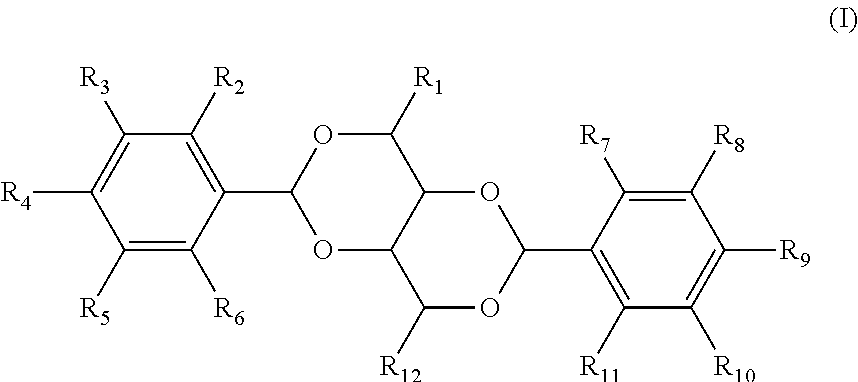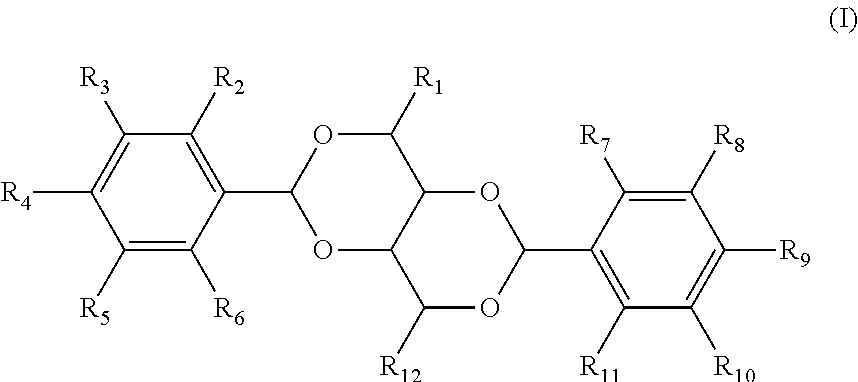Polymer compositions, articles made from such compositions and methods for molding such compositions
a technology of compositions and polymers, applied in the field of polymer compositions, articles made from such polymer compositions, can solve the problems of inability to support itself, and achieve the effects of low haze, desirable surface properties, and desirable optical properties
- Summary
- Abstract
- Description
- Claims
- Application Information
AI Technical Summary
Benefits of technology
Problems solved by technology
Method used
Image
Examples
example 1
[0057]This example demonstrates a method for producing a thermoplastic article in accordance with the invention. Six five-kilogram batches of polypropylene random copolymer samples (samples 1A-1F) were compounded in accordance with the formulations set forth in Table 1 below. Five kilograms of a polymer composition (Polymer Composition A) were made in accordance with the formulation set forth in Table 2 below.
[0058]The fluoropolymer used in this example is Dynamar™ FX 5911 polymer processing additive from 3M. The fluoropolymer is believed to be a terpolymer of vinylidene fluoride, tetrafluoroethylene, and hexafluoropropylene, which exhibits a melt from rate of approximately 10.8 g / 10 minutes as measured in accordance with ASTM D1238-04c at 265° C. using a 5 kg weight. Dynamar™ FX 5911 is also believed to be substantially free of interfacial agents. The peroxide used in this example is Trigonox® 101, a 2,5-Dimethyl-2,5-di(tert-butylperoxy)hexane from Akzo Nobel. The polypropylene ran...
example 2
[0066]This example demonstrates a method for producing a thermoplastic article in accordance with the invention.
[0067]ISPLEN® RC530 polypropylene random copolymer was used in this example. The resin as received was labeled as sample 2A. The same resin was used to make Samples 2B-2D. All Samples 2A-2D contain approximately 2000 ppm of NX8000K clarifying agent and approximately 90 ppm of DynamarTM FX5911 polymer processing aid.
[0068]Samples 2B-2D were melt compounded on a Leistritz Micro27 GL-40D twin screw compounding extruder with two 27 mm diameter screws and length / diameter ratio of 40:1. The barrel temperature of the extruder was set to approximately 230° C. along the entire barrel (flat temperature profile), the throughput was set at 30 kg / h, and the screw speed was set 265 rpm for Sample 2B, 415 rpm for Sample 2C, and 495 rpm for Sample 2D. The extrudate (in the form of four strands) for each sample was cooled in a water bath and subsequently pelletized.
[0069]The melt flow rate...
PUM
| Property | Measurement | Unit |
|---|---|---|
| temperature | aaaaa | aaaaa |
| melt viscosity | aaaaa | aaaaa |
| melt viscosity | aaaaa | aaaaa |
Abstract
Description
Claims
Application Information
 Login to View More
Login to View More - R&D
- Intellectual Property
- Life Sciences
- Materials
- Tech Scout
- Unparalleled Data Quality
- Higher Quality Content
- 60% Fewer Hallucinations
Browse by: Latest US Patents, China's latest patents, Technical Efficacy Thesaurus, Application Domain, Technology Topic, Popular Technical Reports.
© 2025 PatSnap. All rights reserved.Legal|Privacy policy|Modern Slavery Act Transparency Statement|Sitemap|About US| Contact US: help@patsnap.com



